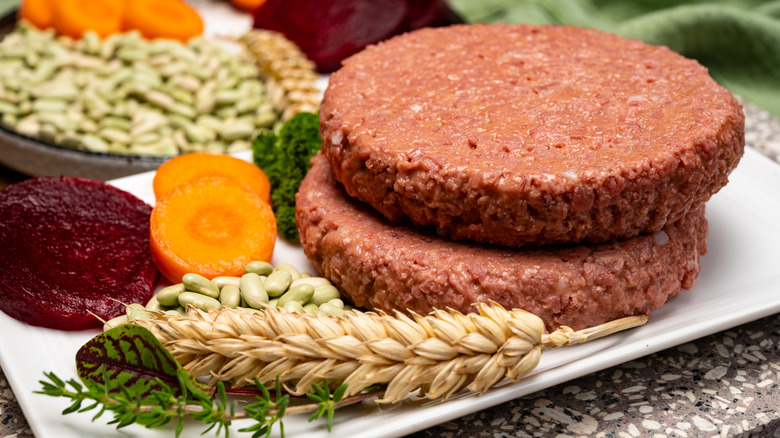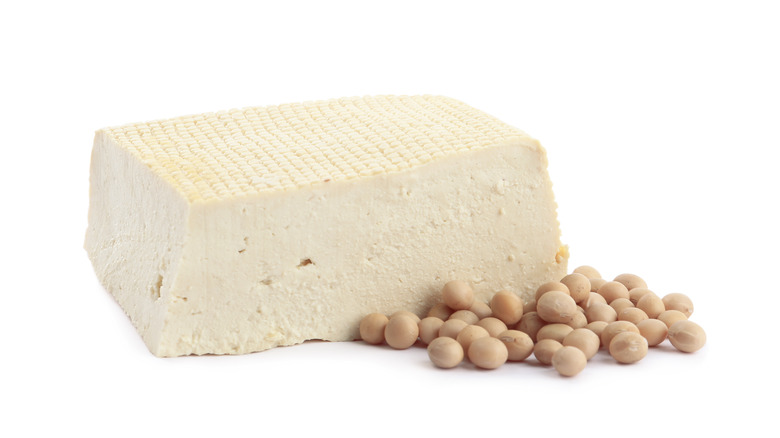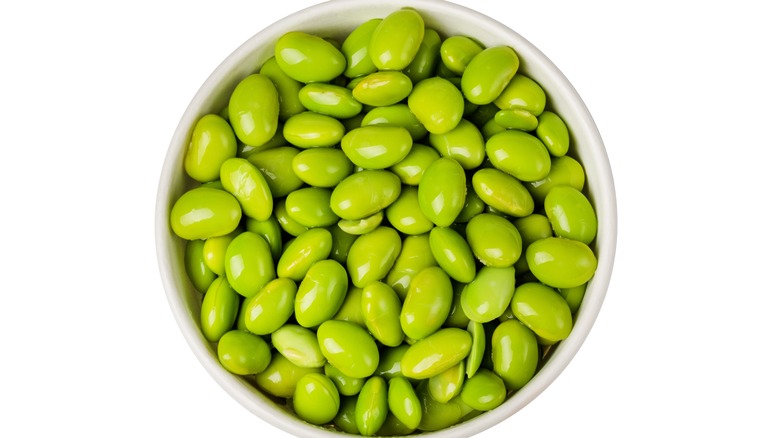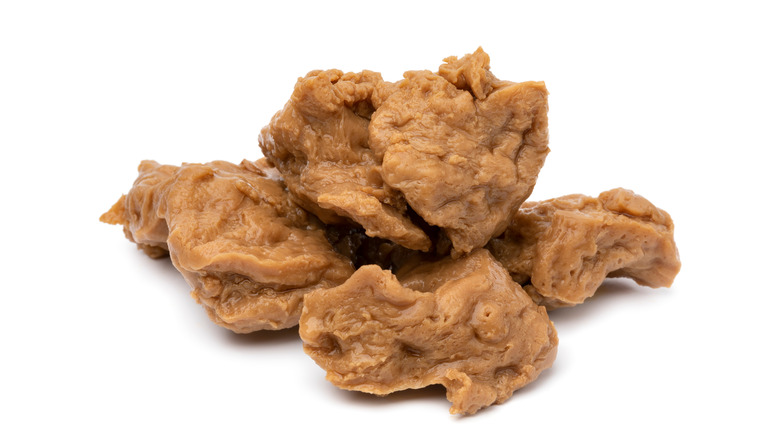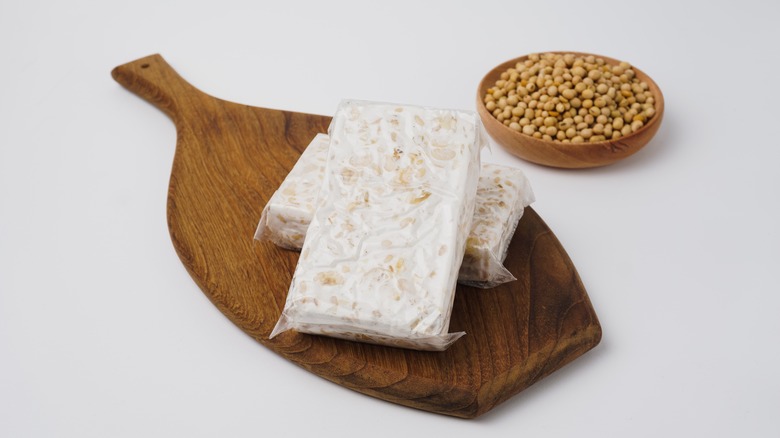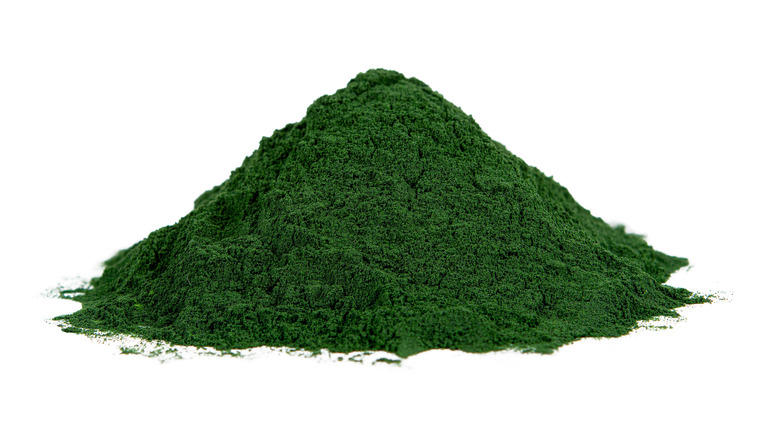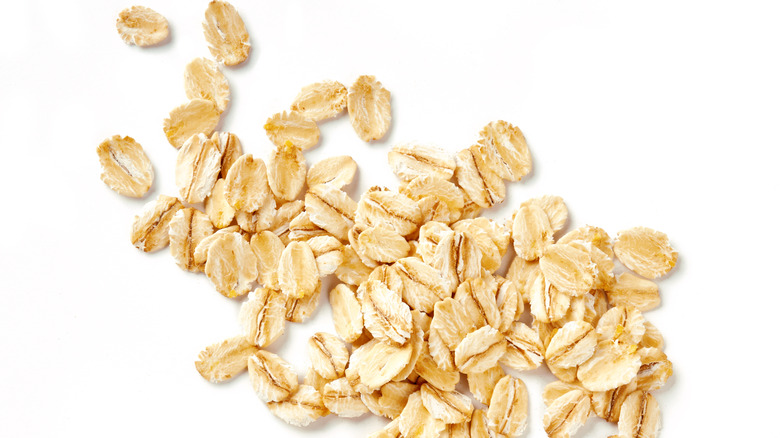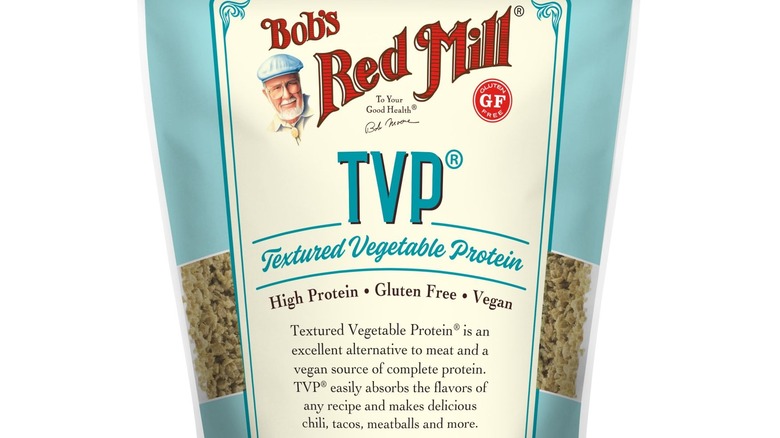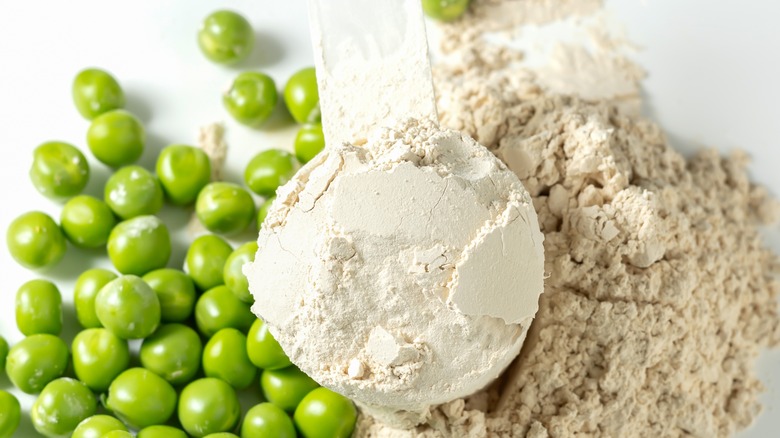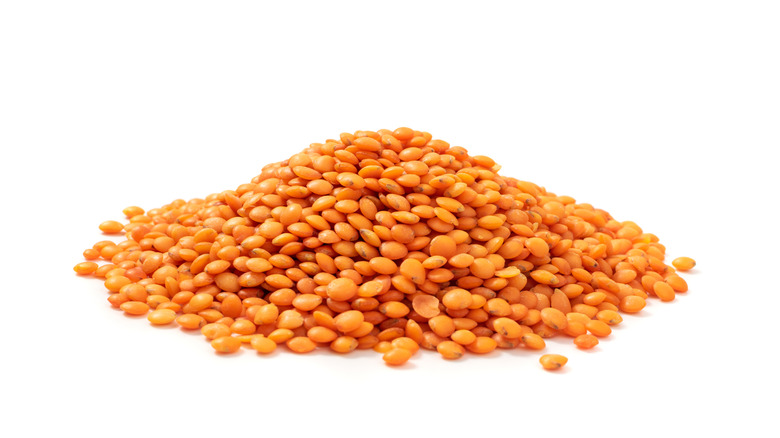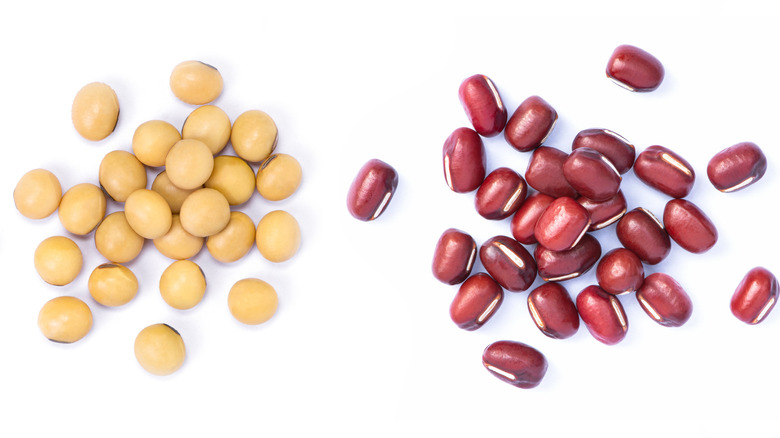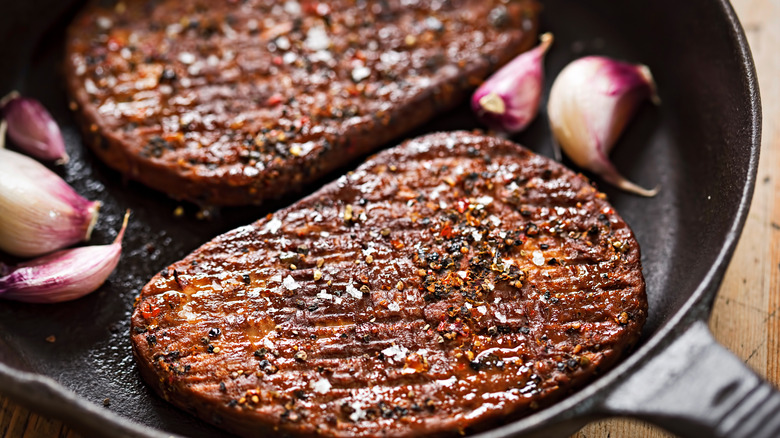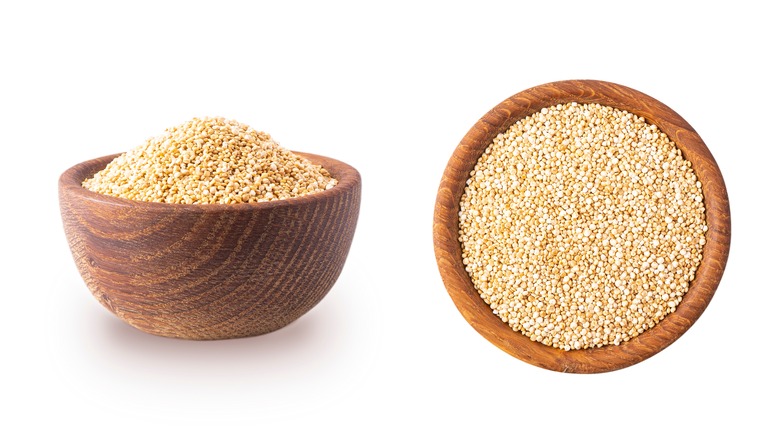15 Sources Of Vegan Protein, Explained
According to the Alliance for Science at Cornell University, one in 10 Americans consider themselves to be either vegan or vegetarian. This figure has skyrocketed in recent years with increased concern about the environmental impact of eating meat, dairy, eggs, and seafood, as well as the ethical implications of consuming animal products. And the folks eating plant-based protein alternatives don't always ascribe themselves to a label; many folks interested in plant-based proteins are "reducetarians" — folks interested in eating less meat but not desiring to quit animal products altogether.
There are many benefits to substituting animal-based proteins with plant-based options. From a health perspective, eating more plant-based proteins can diminish the risk of some chronic diseases like diabetes, high blood pressure, and coronary heart disease, per the Harvard School of Public Health (HSPH). The HSPH also found that even marginally diminishing your daily intake of meat and dairy products can improve health outcomes.
With the sheer amount and variety of plant-based protein sources on the market, you can surely find a suitable replacement for animal-based proteins with just a little bit of research. We've compiled some of the most widely-known sources of plant-based protein, as well as some recommendations for recipes and working with each of the proteins.
Tofu
Tofu is one of the common proteins introduced when folks start talking about plant-based alternatives. Tofu is made from soybean curd and refined into several different consistencies including smooth (custard-like), firm, and extra-firm. According to BBC Good Food, a 3.5-ounce serving of tofu contains around 70 calories and 8 grams of protein. The protein in particular is important, because tofu contains all nine amino acids essential for the human body to function.
There are many ways to use tofu that don't involve just eating the bland block raw. You can cook it with nutritional yeast to make a tofu scramble to replace eggs, or roll cubes in flour and cornstarch to make crispy air-fried tofu. When preparing tofu, it's important to choose a type that fits the desired texture of your dish. For example, smooth tofu is best for a chocolate mousse, while extra-firm tofu stands up best to frying and baking.
Edamame
Edamame are young soybean pods with an earthy, lima-bean-like texture. One cup of the superfood contains close to 20 grams of protein as well as a healthy serving of fiber, vitamin K, and folate, per Healthline.
Edamame is typically eaten after the pod has been steamed or boiled. If you choose to purchase the entire pod of edamame from the grocery store (which you'll find most frequently in the frozen vegetable aisle), you'll want to scrape the pod between your teeth and allow the seeds to fall out. You can jazz up edamame by cooking the entire pod in a spicy garlic sauce with chili paste, tamari, and fresh chopped garlic. Edamame is the perfect, protein-rich appetizer for an Asian-inspired entree. You can also toss salted edamame in a salad with tofu, cabbage, and seasoning for an extra boost of protein. Cooked edamame is a nice textural contrast in fried rice or a grain bowl as well.
Seitan
Seitan is one of the most protein-dense options for vegans and vegetarians. Seitan is actually made of a wheat protein isolate that has existed in Asian countries for centuries. Unlike other meat alternative products, seitan is made by combining vital wheat gluten, other types of flours, seasonings, and broth before steaming the "log" and sautéing as desired. This "wheat meat" can be used as a replacement for beef in stir-fries or shredded thinly for a meatless bacon.
Because seitan contains gluten in its purest form, it's not possible to make a gluten-free alternative for this protein. According to Healthline, a single quarter-cup serving of seitan contains 21 grams of protein and 104 calories, thus making it one of the most protein-dense and low-calorie vegan protein alternatives.
The texture and flavor of seitan are certainly acquired; too much wheat gluten and not enough "filler" (which can include chickpea flour, beans, or soy) can make the seitan resemble the texture of a rubber tire. Simmering at an incompatible heat or kneading the dough too much can also cause the seitan to become inedible (via I Am Going Vegan).
Tempeh
If you've ever wondered what tempeh is, you're not alone. It's a combination of popular grains and legumes (typically soybeans) fermented with a mold culture. Some of the popular grains manufacturers use in the tempeh block include millet and barley, but the exact grain mix can vary. The resulting product is a firm block covered in a thin white mold. Appetizing, right?
It may be difficult to stomach the idea of eating a block of fermented grains, but tempeh is actually a flavorful addition to chili, stir fry, and grain bowls if it is prepared well. The consistency is chewy and grainy without an overwhelming flavor of fungus. According to Well + Good, besides containing a ton of helpful probiotics, tempeh has 20 grams of protein per 3.5-ounce serving. You'll notice a strong umami flavor when the tempeh is marinated with coconut aminos, tamari, or soy sauce, or shredded with other umami-rich ingredients like tomatoes or mushrooms. We recommend looking for tempeh in your grocery store alongside other plant-based protein options like tofu. Once the package has been opened, the tempeh can last up to five days.
Nutritional yeast
Nutritional yeast is a yellow, cheese-dust-like powder that is commonly used in vegan food as a seasoning. It's manufactured from deactivated yeast from the molasses plant. Not only do vegans love nutritional yeast for its utility in the kitchen, but also because the powder is one of the only plant-based sources of vitamin B12. According to Forks Over Knives and a study published in the European Journal of Clinical Nutrition, 86% of vegans do not consume adequate B12 because it is most commonly found in animals and some bacteria. B12 deficiency can cause anemia, neuro-cognitive damage, and potentially more harmful long-term impacts. One quarter-cup of nutritional yeast contains 60 calories and 8 grams of protein.
Nutritional yeast has many applications, one of which is a critical flavoring for homemade vegan cheese sauce. You can also use nutritional yeast to thicken soups. If you're looking for a convenient way to add more protein to a late-night snack, try sprinkling nutritional yeast on your popcorn.
Hemp protein
Hemp protein is far from the bioactive drug. The powder is made from grinding hemp seeds down into a flavorful, earthy dust perfect for smoothies, protein shakes, and oatmeal. The powder has a very distinct, dirt-like flavor that some consumers can find off-putting. According to Healthline, one quarter-cup serving of hemp protein powder contains 120 calories and close to 15 grams of complete protein. Plus, hemp protein contains between 7-8 grams of fiber per serving; fiber is important for a healthy gut and to increase feelings of satiety.
aModrn notes hemp protein has a higher digestibility than whey protein and pea protein. Hemp protein is free from oligosaccharides, which nutritional research notes are not digested in the human gut. Oligosaccharides are present in pea protein and whey protein and have undesirable side effects like excess flatulence and intestinal discomfort. Besides its higher digestibility, hemp seeds also contain omega-3 fatty acids, zinc, magnesium, and B vitamins.
Spirulina
Spirulina is a very new-age protein made from an algae called Arthrospira platensis. In the wild, this protein-rich algae grows near mineral-rich bodies of water (via Auroville), but has since been cultivated indoors to maximize its growth. Consumers can purchase spirulina in one of three forms: powdered, pilled, or fresh. Research indicates fresh spirulina contains more bioactive components like carotenoids, chlorophyll, phenols, and flavonoids than dried spirulina.
Spirulina's taste, like some other vegan proteins, is acquired. Its algal profile can make the taste of spirulina resemble seaweed. Despite its flavor, spirulina provides a bright blue hue to foods like smoothies. Although less popular, spirulina can also be used in pesto, eggs, and omelets as well. According to Healthline, 1 tablespoon of the algae provides 4 grams of protein and 20 calories. You'll also find a hefty amount of your recommended daily intake of copper, iron, and vitamin B2.
Oats
The humble oat is a breakfast classic, and for good reason. This grain is filled with plant-based protein; one half-cup serving of oats has 4 grams of fiber and close to 5 grams of protein (via WebMD). And the type of oat isn't as important to its nutritional composition, so you can keep eating those whole rolled oats or your favorite steel-cut brand.
Oats are more versatile than you think. You can make oat flour by pulsing oats in your food processor and use it as a substitute for white flour in your banana bread or homemade pancake recipe. The result is a higher-fiber, higher-protein consistency batter. You can also use oat flour to maintain the consistency of your favorite homemade meatball recipe. If you would rather keep the oats whole, try making a filling bowl of oatmeal for breakfast at least once a week, or make overnight oats for an easy pre-work breakfast.
Textured vegetable protein
If you miss the texture of ground beef or turkey, you might turn to textured vegetable protein (TVP) first. According to ChooseVeg, TVP was introduced in the 1960s as an ingredient added to meat to make it last longer. One quarter-cup provides up to 13 grams of protein with a mere 90 calories. TVP is sold dried (and can last up to 20 years) and is easily rehydrated with warm water or broth.
Once rehydrated, you can cook TVP similar to other types of ground meat or poultry. We recommend replacing ground taco meat with rehydrated TVP and taco seasoning. Or, for a meatier vegan chili, you can add chili to the pot with your favorite chili spices, beans, and vegetables. You can also purchase pre-seasoned TVP, like Trader Joe's soy chorizo. Although these processed foods typically have more flavor than DIY-TVP, these products may carry a hefty amount of your recommended daily intake of sodium and saturated fat.
Pea protein
Pea protein is an incredibly versatile powder. There's no wonder it's commonly eaten in plant-based protein bars and shakes or in some processed alternative meat products. The protein contains all nine of the essential amino acids and iron. The protein is also high in fiber, which can promote fullness.
One serving of pea protein isolate, which according to Cleveland Clinic is made from pea protein and amino acids, contains 15 to 20 calories per 3.5-ounce serving. Pea protein concentrate is another type of pea-based protein that includes fats and carbohydrates to promote satiety. Alternative meat products, like Beyond burgers, are made from pea protein because of its digestibility, high protein, and amino acid richness. Scientific research indicates that both wheat and pea protein may be preferable to more traditional soy proteins because of similar textures to some kinds of meat, simple flavors, and nutritional profiles akin to animal-based proteins.
Lentils and lentil flour
Lentils are a colorful superfood rich in protein, fiber, and carbohydrates. According to Healthline, 1 cup of cooked lentils contains slightly more calories than other vegan protein sources, clocking in at 230 per serving, but offers comparable protein at around 18 grams per serving. Research indicates lentils are rich in prebiotic fiber, which helps promote a healthy gut microbiome for optimal digestion.
Different kinds of lentils have different uses. Yellow and red lentils are fast-cooking and can be pureed or used in a traditional dal while black, brown, or green lentils can hold up to salads or soups. Lentil flour, according to Bakerpedia, is often used in gluten-free baking flours as a stabilizer and water-holding agent. One of the potential benefits (or drawbacks, depending on the desired outcome) is that the lentil will impart a unique color to the dish because of naturally occurring pigments in each pod. Lentil flour also has a nutty, distinct flavor.
Beans and bean flour
Beans have many of the same characteristics as lentils in cooking. These legumes are filled with fiber and protein and can be just as delicious.
There are many types of beans you can adapt into cooking and recipes. One cup of chickpeas (garbanzo beans) has around 270 calories, close to 35 grams of carbohydrates, and between 10 and 15 grams of protein (via WebMD). These soft beans can be integrated into our favorite dip (hummus) or roasted on a baking sheet. Black beans are also high in protein; a quarter-cup of black beans contains around 165 calories, 10 grams of protein, and 30 grams of carbohydrates (via WebMD).
Beans are very versatile for appetizers, entrees, and even desserts. Craft a spicy black bean soup for a filling winter dish or roast crispy chickpeas for a simple snack. For dessert, take out your high-speed blender and make simple black bean brownies.
Nuts and nut butters
Nuts can provide a robust nutritional profile with adequate fats, fiber, and protein. Peanuts, although commonly grouped with other nuts, contain the highest amount of protein per serving compared to other nuts. According to the USDA, one serving of unroasted peanuts contains 26 grams of protein, around 49 grams of fat, and over 560 calories. Almonds, per the Harvard School of Public Health, contain 6 grams of protein per quarter-cup serving.
The protein and fat in even a small serving of nuts provide a strong feeling of satiety. You can add a small serving of nuts to a trail mix or on top of a salad to suppress your hunger and boost your daily protein intake. Folks allergic to tree nuts are not able to eat almonds, cashews, or other nut types. However, many of these nut flours can be processed into gluten-free flour replacements.
Mycoproteins
Mycoproteins are somewhat unconventional proteins made from a fungus called Fusarium venenatum, per research published in Current Developments in Nutrition. Sold commonly as Quorn, this mycoprotein has a significantly lower carbon dioxide and water footprint than other meatless protein options on the market. It packs a nutritious punch, too — a 3.5-ounce serving of mycoprotein contains 85 calories and 11 grams of protein. Per the brand, Quorn uses free-range eggs as a binder in the final steps of production as well as some plant proteins in vegan products, so it's important to check the product label before consuming.
Quorn's current lineup contains chiQin filets (vegan), meatless grounds (with egg), turkey deli slices (with egg), and meatless strips (with egg). You can prepare Quorn similar to other vegan meat alternatives and thaw the serving when you are ready to eat. Substitute meatless grounds or strips in a burrito, or use the deli slices for a sandwich.
Quinoa
Quinoa is a popular, versatile grain used in many recipes. The pseudo-cereal is made from a 5,000-year-old grain cultured in South America. Quinoa can come in several different types, including the seed, which can be cooked similarly to other grains like barley and amaranth. Quinoa flakes have been rolled and flattened, and can be used for overnight "oats" or to boost chewiness in a cookie. Quinoa flour is naturally gluten-free and can be used for cookies, cakes, or granola bars. If you want to save some pennies and make your own quinoa flour at home, you can toast raw quinoa in a skillet before adding the quinoa to a spice or coffee grinder (via Super Healthy Kids).
One cup of cooked quinoa contains a little over 220 calories, 8 grams of protein, and 39 grams of carbohydrates, per Healthline. Whole quinoa can be sprinkled over a salad or included in a grain bowl with your favorite dressing.
